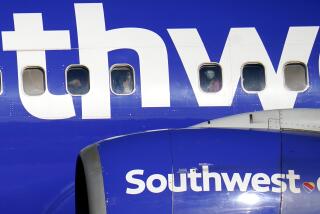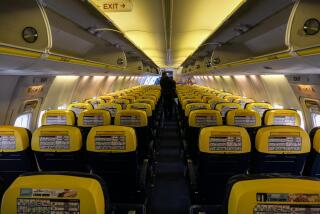FAA Proposal Would Change Rules for Exit Seats
Sitting in an exit row on a domestic flight may turn out to be a responsible position.
The FAA is proposing to ban certain passengers from sitting in an exit row because of safety considerations.
Any passenger deemed incapable of operating emergency exits without assistance, or who might impede the evacuation of passengers, would have to be seated elsewhere.
The proposal affects passengers with physical and mental disabilities, parents with young children, obese, aged and frail people, people with injuries, children traveling alone and anyone else who could slow down an evacuation. Conceivably, passengers who don’t speak English could also be affected.
The FAA only provides airlines with general guidelines in this area; the proposal has been designed to create a standard rule. So far, there is only confusion among carriers and travelers on the subject.
Procedures as well as implementation of policies can differ from airline to airline, even from plane to plane within the same fleet.
The FAA said it has focused on this issue because most passengers are not aware of the requirements for quick and effective action needed to handle an evacuation.
Little Latitude
“The airlines wouldn’t have a great deal of latitude under the guidelines in this proposal,” an FAA spokesman said. “There might be some variations between the carriers because of different aircraft, but the rules will be basically the same.”
Each airline would have to submit its procedures to the FAA for approval.
Because evacuation time is crucial to survival after an accident, the FAA wants to make sure the chances are high that emergency exit doors and windows will be opened quickly and properly.
A fire or toxic fumes can take their toll in seconds. And often crew members are not in a position to lead this part of the evacuation. Thus, passengers sitting near the doors must help open these exits.
Survival time involving a fire after a crash may be as short as 30 seconds, according to the FAA.
The FAA report, based on various studies, indicated that the most critical phase of an evacuation is the beginning--getting the exits open safely and deploying evacuation slides.
“Time lost during this initial part of the evacuation can never be made up, whereas once the evacuation lines begin to form, time lost in getting to these lines is not as critical and can be compensated for,” the FAA proposal said.
The FAA has set out specific criteria to be met by passengers sitting in exit rows.
First, a passenger must be able to find the exit and follow instructions for using it. Exit operations and instructions in words and graphic displays differ from plane to plane.
A passenger also has to be able to open the exits, which may be heavy and clumsy to manipulate.
Additional Responsibilities
Even trickier, a person must be able to determine when to open the exit door. This means being able to make a judgment on when opening a door would be too dangerous, such as when there’s fire from an adjacent wing.
Passengers should be able to assess distance to the ground and such other hazards outside the exit as jagged pieces of metal, ice, water or other obstacles.
Passengers should also be able to assess whether a slide can be used safely or not. Has the slide been extended, and does it end in a safe area?
Automatic slides fail from time to time, the FAA said, and the person nearest the exit must be able to recognize that manual deployment will be necessary, find the manual deployment handle and operate it.
Passengers should also have the ability to respond to shouted or hand-signal instructions from flight attendants, and possibly to help other people leave the danger zone around the aircraft.
A passenger has to be able to go quickly through an open exit and not create a traffic jam.
Given these potential tasks, airlines need to take new steps to advise passengers sitting in exit rows about what functions they might have to perform in an emergency.
Moreover, the carriers would need to verify that appropriate passengers are sitting in the exit rows before takeoff, and be responsible for briefing passengers on their option of moving out of the exit row if they can’t handle the responsibilities that go with seats there.
Judging Passengers
Carriers would also have to train flight crews to make more informed judgments about the capabilities of passengers.
“This kind of judgment call can make for ill feelings between passengers and flight attendants,” said Yvonne Nau, a spokeswoman for the Travel Industry Disabled Exchange, a Los Angeles-based trade group.
The proposal, said the FAA, does not run afoul of the Air Carrier Access Act of 1986 that prohibits discrimination in air transportation on the basis of handicap, because the act also requires that when measures are enacted to avoid discrimination that they take into account the safety of all passengers.
The FAA report stated that the proposal offers a rule “that will emphasize the ability of a person to perform critical safety-related functions and not the presence or absence of a disability.”
Disabled passengers and associations representing handicapped travelers may disagree.
“We feel this proposal by the FAA is just a cover for blatant discrimination against disabled and blind travelers and nothing really new,” Nau said.
Send your comments on the FAA proposal by June 13 to the Federal Aviation Administration, Office of Chief Counsel, Rules Docket, Docket No. 25821, 800 Independence Ave. S.W., Washington, D.C. 20591.
More to Read
Inside the business of entertainment
The Wide Shot brings you news, analysis and insights on everything from streaming wars to production — and what it all means for the future.
You may occasionally receive promotional content from the Los Angeles Times.










